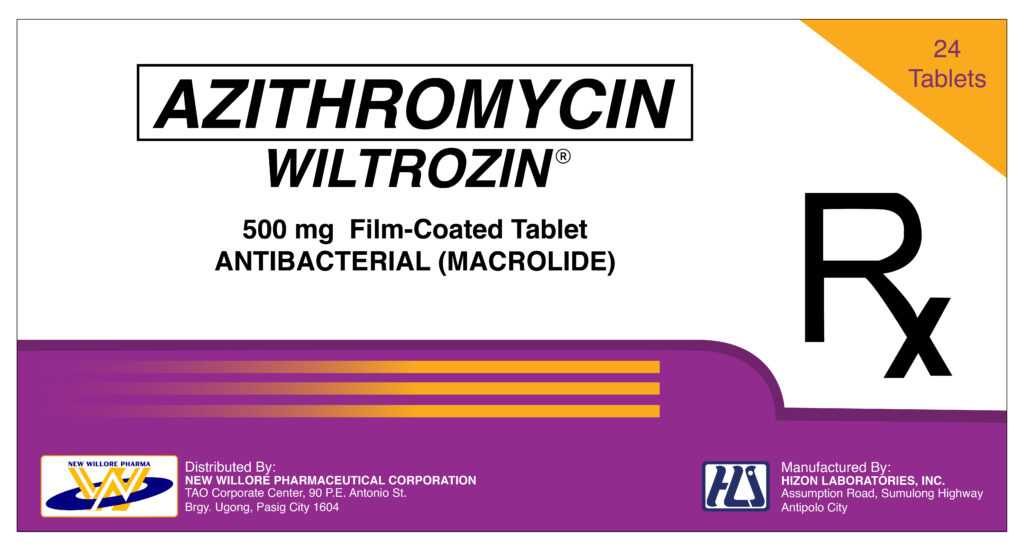WILTROZIN

Generic Name:
Azithromycin (dihydrate)
Pharmacologic Category:
Macrolide
Pharmacodynamics:
Pharmacotherapeutic group: Macrolides, ATC code J01FA.
Azithromycin is the first of a class of antibiotics designated chemically as azalides. Chemically it is derived by insertion of a nitrogen atom into the lactone ring of erythromycin A. The chemical name of azithromycin is 9-deoxy-9a-aza-9a-methyl-9a-homoerythromycin A. The molecular weight is 749.0.
The mode of action of azithromycin is inhibition of protein synthesis in bacteria by binding to the 50s ribosomal subunit and preventing translocation of peptides.
Azithromycin demonstrate activity in vitro against a wide range of bacteria including:
Gram-positive aerobic Bacteria- Staphylococcus aureus, Streptococcus pyogenes (group A beta-hemolytic streptococcus), pneumoniae, alpha-hemolytic streptococci (viridans group) and other streptococci, and Corynebacterium diphtheriae. Azithromycin demonstrates cross-resistance with erythromycin-resistant Gram-positive strains, including Streptococcus faecalis (enterococcus) and most strains of methicillin-resistant staphylococci.
Gram-negative aerobic Bacteria- Haemophilus influenzae, Haemophilus parainfluenzae, Moraxella catarrhalis, Acinetobacter species, Yersinia species, Legionella pneumophila, Bordetella pertussis, Shigella species, Pasteurella species, Vibrio cholerae and Parahaemolyticus, Plesiomonas shigelloides. Activities against Escherichia coli, Salmonella enteritidis, Salmonella typhi, Enterobacter species, Aeromonas hydrophila and Klebsiella species, are variable and susceptibility tests should be performed. Proteus species, Serratia species, Morganella species and Pseudomonas aeruginosa are usually resistant.
Aerobic Bacteria- Bacteroides fragilis and Bacteroides species, Clostridium perfringens, Peptococcus species and Peptostreptococcus species, Fusobacterium necrophorum, and Propionibacterium acnes.
Organism of Sexually Transmitted Diseases- Azithromycin is active against Chlamydia trachomatis and also shows good activity against Treponema pallidum, Neisseria gonorrhoeae, and Haemophilus ducreyi.
Other organisms: Borrelia burgdorferi (Lyme disease agent), Chlamydia pneumoniae, Mycoplasma pneumoniae, Mycoplasma homonis, Ureaplasma urealyticum, Campylobacter species and Listeria monocytogens.
Opportunistic Pathogens Associated with HIV infections- Mycobacterium avium-intracellulare complex, Pneumocyctis carinii and Toxoplasma gondii.
Pharmacokinetics:
Azithromycin given orally is rapidly absorbed and about 40% bioavailable. Absorption form capsules, but not tablets or suspension, is reduced by food. Peak plasma concentrations occur 2 to 3 hours after an oral dose and 1 to 2 hours after intravenous dosage. However, Azithromycin is extensively distributed into the tissues, and tissue concentrations subsequently remain much higher than those in the blood; in contrast to most other antibacterials, plasma concentrations are therefore of little value as a guide to efficacy. High concentrations are taken up into the white blood cells. There is little diffusion into the CSF when the meninges are not inflamed. Data from animal studies indicate that Azithromycin crosses the placenta. Small amounts of Azithromycin are demethylated in the liver, and it is excreted in bile mainly as unchanged drug and a number of inactive metabolites have also been detected. About 6% of an oral dose (representing about 20% of the amount in the systemic circulation) is excreted in the urine. The terminal elimination half-life is about 68 hours.
Indications:
Azithromycin is a nitrogen-containing macrolide of azalide with wide spectrum of activity that has been used in the treatment of a wide variety of infections caused by susceptible organisms. It is given in the treatment of respiratory tract infections (including otitis media), in the skin and soft-tissue infections, and in uncomplicated genital infections. Azithromycin may also be used as prophylaxis, and as a component of regimens in the treatment of Mycobacterium avium complex (MAC). It is also used in some countries for the prophylaxis of endocarditis in at-risk patients unable to take penicillin. It is also used in the management of trachoma and typhoid

EMAIL US AT
[email protected]
VISIT US AT
Tao Corporate Center 90 P.E. Antonio St.
Brgy. Ugong, Pasig City 1604



